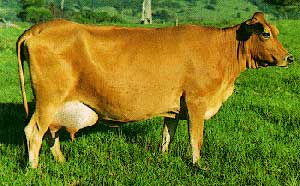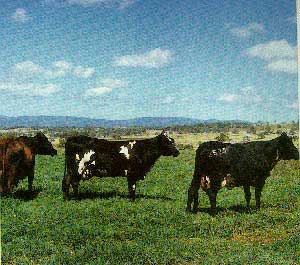Australian Milking Zebu Cattle
 In an effort to overcome the problems of traditional dairy breeds performing at reduced
levels under hot, humid and tick-infested conditions, the Commonwealth Scientific
& Industrial Research Organization (CSIRO) developed the Australian Milking Zebu (AMZ).
This began in the mid-1950’s with the introduction of Pakistani Sahiwal and Red Sindhi
dairy cattle, which were mated initially to high-producing Jersey cattle. Later, some
infusion of Illawarra, Guernsey and Holstein-Friesian bloodlines occurred.
In an effort to overcome the problems of traditional dairy breeds performing at reduced
levels under hot, humid and tick-infested conditions, the Commonwealth Scientific
& Industrial Research Organization (CSIRO) developed the Australian Milking Zebu (AMZ).
This began in the mid-1950’s with the introduction of Pakistani Sahiwal and Red Sindhi
dairy cattle, which were mated initially to high-producing Jersey cattle. Later, some
infusion of Illawarra, Guernsey and Holstein-Friesian bloodlines occurred.
Careful interbreeding of the half-bred progeny, combined with strict selection criteria,
have resulted in the AMZ breed. Selection is for heat tolerance, tick resistance and
milk production alone.
 Mature purebred AMZ cows produce an average of 2,700 liters of milk over a 12 month
period, while AMZ cross Friesian cows average more than this. Quality of milk is very
high and protein level is approximately 3.5 to 4 percent.
Mature purebred AMZ cows produce an average of 2,700 liters of milk over a 12 month
period, while AMZ cross Friesian cows average more than this. Quality of milk is very
high and protein level is approximately 3.5 to 4 percent.
The AMZ carries the color markings and general shape of the Jersey, but also shows the tropical influence of the Sahiwal and Red Sindhi breeds through the ability to sweat and discard ticks from a highly mobile, loose skin.
References
Handbook of Australian Livestock, Australian Meat & Livestock Corporation, 1989, 3rd Edition
